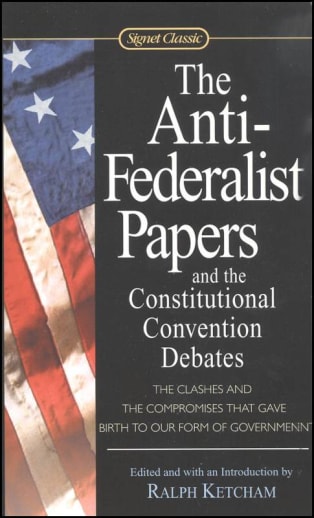While the Federalist Papers defended the Constitution and its strong central government, the Anti-Federalist Papers include opinions from such important thinkers as Patrick Henry and John DeWitt, who saw certain threats against rights and liberties in the Constitution. These threats are identified and argued against in the writings. Though the Anti-Federalists lost, they came close to winning, and many of their arguments and beliefs are still strongly present in American politics today. Included in this book are the complete texts, manuscripts from the Constitutional debates, commentaries, and an Index of Ideas. It also lists cross-references to its companion volume The Federalist Papers (item # 031225), so if you have both books you can easily find what each group thought about a particular topic. 406 pgs, sc. ~ Rachel
Anti-Federalist Papers
Description
First Semester Primary Books: Westminster Confession of Faith, The Pilgrim's Progress, Of Plymouth Plantation, The Social Contract, Foundational American Documents, Federalist and Anti-Federalist Papers, A Tale of Two Cities.
First Semester Secondary Books: Foxe's Book of Martyrs, Frankenstein, Pride and Prejudice, Gulliver's Travels, Autobiography of Benjamin Franklin, The Pit and the Pendulum, The Adventures of Tom Sawyer.
Second Semester Primary Books: Reflections on the Revolution in France, Uncle Tom's Cabin, Lincoln's Speeches, Slave Narratives, The Communist Manifesto, The Treaty of Versailles, The Great Gatsby, Mein Kampf, Philemon, The Epistles of John, The Epistles of Peter and Jude, Nineteen Eighty-Four, Daniel.
Second Semester Secondary Books: Little Women, The Killer Angels, Christianity and Liberalism, The Old Man and the Sea, Animal Farm, Death of a Salesman, Postmodern Times, How Should We Then Live?
| Product Format: | Softcover Book |
|---|---|
| Grades: | 9-12 |
| Brand: | Signet Books |
| Author: | Ralph Ketcham |
| ISBN: | 9780451528841 |
| Length in Inches: | 6.75 |
| Width in Inches: | 4.25 |
| Height in Inches: | 1 |
| Weight in Pounds: | 0.5 |
| Ages: | AD |
| Pages: | 416 |
| Publication Date: | 5/3/2013 |

